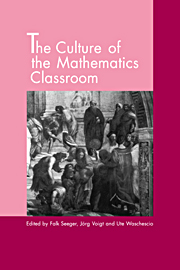Book contents
- Frontmatter
- Contents
- List of contributors
- Acknowledgments
- Introduction
- Part I Changing classroom culture
- Part II Classroom processes
- 5 Reasoning processes and the quality of reasoning
- 6 A constructivist perspective on the culture of the mathematics classroom
- 7 The culture of the mathematics classroom: Negotiating the mathematical meaning of empirical phenomena
- 8 The missing link: Social and cultural aspects in social constructivist theories
- Part III Epistemology and classroom culture
- Part IV Outlook
- Author index
- Subject index
5 - Reasoning processes and the quality of reasoning
Published online by Cambridge University Press: 03 May 2010
- Frontmatter
- Contents
- List of contributors
- Acknowledgments
- Introduction
- Part I Changing classroom culture
- Part II Classroom processes
- 5 Reasoning processes and the quality of reasoning
- 6 A constructivist perspective on the culture of the mathematics classroom
- 7 The culture of the mathematics classroom: Negotiating the mathematical meaning of empirical phenomena
- 8 The missing link: Social and cultural aspects in social constructivist theories
- Part III Epistemology and classroom culture
- Part IV Outlook
- Author index
- Subject index
Summary
Introduction
Language in mathematics instruction
Any study of processes of mathematical learning is confronted repeatedly with the interdependence of student and teacher behavior. Observed student errors will often be explained in terms of difficulties of understanding or of grasp. Teachers will describe this situation by saying, “The student does not understand the content (however often I explain),” whereas the student will complain, “The teacher is unable to explain.” In positive terms, students tend to characterize a “good teacher” as one who “is good at explaining.” Thus, how language is used as a means of communication is crucial for mathematics instruction, and, hence, for how mathematics is learned. This is why analyzing the communication processes in the mathematics classroom is such an important task for research on the didactics of mathematics. Differences in linguistic competence between teachers and students will lead to different language use, a fact described aptly by introducing the terms “teacher language” and “student language.” Studies in this problem field will thus be concerned with the mutual dependencies in the relationship between teacher and student language and pursue, in particular, the question, “How can this student language, and, in particular, student reasoning, be described?”
The dual role of language in mathematics instruction becomes evident when we realize that mathematics is presented in this medium. However, the symbolic character of so-called mathematical language as its most salient feature often obscures its grammatical and semantic structure.
- Type
- Chapter
- Information
- The Culture of the Mathematics Classroom , pp. 127 - 157Publisher: Cambridge University PressPrint publication year: 1998



